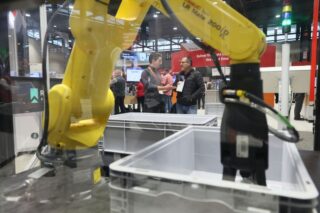Times may change, but technological innovation in the manufacturing industry continues at the same fast pace as ever. Currently, the focus is on generative AI, which promises to improve processes, products, and services. But can this new technology be used safely when it comes to generative design? And perhaps the most important question of all – how do we ensure a beneficial collaboration between machines and humans? Cédric Kalifa, France Country Manager at PTC, explains.
I smiled when I saw a post on Instagram that basically said, “I don’t want AI to do my art and writing, I want AI to do my laundry and my dishes.” I have to admit that I rather agree with this comment… As the country manager of a leading industrial software company, I often ask myself – how can we integrate AI into our processes? And what role should this new technology play to actually help our customers grow? In other words, should generative AI for the manufacturing industry be “creative” or “supportive”?
Generative design, an iterative design process using specialized software, has the potential to transform several areas within the manufacturing industry. This includes production manufacturing, facilitating the design of complex and resource-efficient components, and boosting innovation. There are therefore many possibilities with generative design, especially when combined with AI.
READ ALSO
The Importance of a Strong AI Foundation
All generative design today is more or less designed to act as support. For example, an engineer can ask a question or provide a prompt to AI to get suggestions for ideas and methods to improve or develop a product. A question like, “How can we improve this product from an ecological perspective?” can yield suggestions that the engineer can choose – or not – to implement. Thus, almost anything is possible with AI, but what is feasible and – perhaps the most important question – what is desirable? In other words, how much do we want AI to be able to do?
In my view, the main purpose of AI should be to save time and increase productivity. To get the most out of your AI usage, it is important that the AI you use is based on data that is specifically relevant to you and your business. This, in turn, allows generative technology to identify improvement areas that are important to you, your market, your customers, and your suppliers.
In the automotive industry, generative design is used to optimize vehicle components by reducing their weight or improving their capacity. The more scenarios considered and the more parameters taken into account, the greater the opportunities for successful product development. In this context, AI can, in many ways, challenge us to find the best solutions. A few years ago, when Volkswagen redesigned its microbuses, they used generative design. The result was that they created new wheels that were 18% lighter than the standard set, while also reducing the overall development time from 1.5 years to just a few months.
READ ALSO
Dialogue Is Key
Generative design with AI in the manufacturing industry can thus be compared to a collaboration between machines and humans, aimed at creating components that are lighter, stronger, and cleaner. It is this dialogue that is interesting, and it is this dialogue that engineers or operators must understand and engage with. It is a dialogue so important that I would argue the debate should not focus primarily on whether AI should be seen as creative or supportive, but rather on the conversation between human and AI – the collaboration – which should be the focus and specifically tailored to each company and operation to achieve the best possible results.
The generative AI revolution in the manufacturing industry will only be possible if the industry and companies within it ensure that AI has access to business-specific data and processes and adapts the technology to deliver relevant data. After all, the quality of the information AI generates is directly linked to the quality of the data you and your business provide access to.






![Image [BUYING GUIDE] How to Choose the Right Industrial Robot?](/wp-content/uploads/sites/3/Industrial-Robot-320x213.jpg)

![Image [Buying Guide] How to Choose the Right Safety Shoes?](/wp-content/uploads/sites/3/Safety-Shoes-320x213.jpg)


![Image [Buying Guide] How to Choose the Right AMR?](/wp-content/uploads/sites/3/AMR-320x213.jpg)